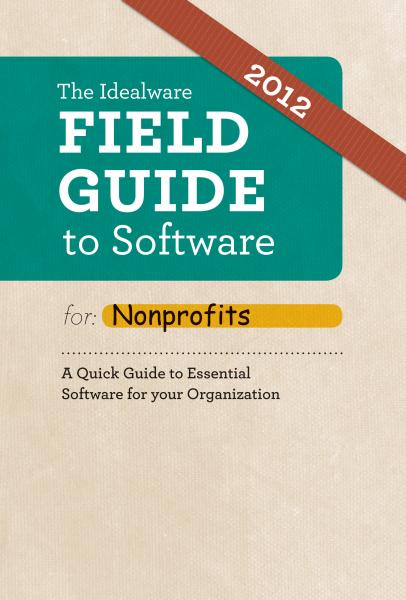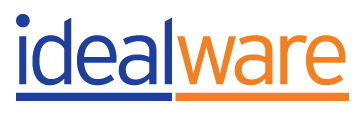Idealware is a nonprofit organization based in Portland, Maine. It helps other nonprofits make “smart software decisions” by offering recommendations on software products and vendors, and more importantly, on which of those products and vendors would best fit the organization’s specific needs. Idealware’s reports are plenty, thoroughly researched, relevant and up-to-date.
Idealware provides an authoritative online guide to the software that allows U.S. nonprofits--especially small ones--to be more effective. By synthesizing vast amounts of original research into credible and approachable information, Idealware helps nonprofits make the most of their time and financial resources.
Below is just a sample of the many published reports available online to download for free:
• Streamlining Online Grant Applications: A Review of Vendors
• The Nonprofit Social Media Decision Guide
• A Consumers Guide to Low Cost Donor Management Systems
• Do You Need a New Donor Management System? A Step-by-Step Decision Making Workbook
• A Consumers Guide to Low-Cost Data Visualization Tools
We have featured many of Idealware’s reports and findings on the blog. So today, I am pleased to introduce you to Laura Quinn, Founder and Executive Director of Idealware. Read on to learn more about Laura’s thoughts on the value of a social media plan, making the decision to upgrade to a new software system, the process of adjusting to change with a new system, and mobile fundraising.
1. How important is it to have a social media plan (a formalized document or an abstract vision)?
Having a plan in general, is always really critical for any technology or communications effort. But with social media, it is particularly important to be aware of—and it is all too easy—to be peer pressured into it, the idea of being on Facebook because everyone else is. To avoid this, think through what your goals are. Though it has proved to be a useful way to reach out, it does not necessarily mean you should be doing it right now if it does not align with your goals. Once you have identified your goals for technology development or communications, figure out what you are attempting to do and what tools you will need to achieve that. Then move forward.
Go through the Social Media Workbook and fill it out yourself. The greatest value of a plan is not reaching an answer; it is walking through the process with staff members answering the questions and identifying your goals. This allows for an aligned vision of how things fit into the mission, what kind of effort that requires, and what staff will and should be involved.
It is valid to say that social media is still not yet a place where we are focusing our energies. Because of this, it is not that crucial to have a formal document (unless that is the culture of your organization).
2. For small arts organizations in the initial stages of planning for new software, what are the first three questions they should ask before implementing any new technology?
1) What software do I need to ensure me and any staff member can make the most efficient use of our time? Nonprofits, in my experience, often skimp on things like usable recent versions of word processing, spreadsheets, graphics software—it is critical to think about whether they could save time with new software, and if so, what the approximate dollar value of that time it. For most nonprofits, payroll is the vast majority of the budget, and if you get even 1% more efficiency out of your staff, that can be equivalent to a huge dollar value.
2) What do I need to ensure reliable and continuing access to our files? This encompasses good file sharing solutions and most critically, backup solutions.
3) What do I need to understand about how are constituents are interacting with us? This simple question encompasses a world of complexity—donor management, client tracking, prospecting, event or member tracking…but it is one of the most important areas to consider
3. Once an organization has decided on a new software system, how can they best prepare for its implementation?
Remember that buying a package is only half of the project in getting it actually ready to be used. You have to think about moving data from the old system to the new system (if this applies), which is a very complicated and often underestimated process. Think about the processes for using the system. If staff is not using it in consistent ways, the data becomes useless. You must define the process for using the software so everyone knows what is supposed to be entered in each field, the correct formatting for each field, etc. Make sure staff are comfortable using the interface. If they are not, they will find workarounds which defeat the purpose of implementing the new system.
4. Implementing a new software program is an enormous project- in terms of time, money and human labor. For small arts organizations interested in implementing new software, but concerned with what they will have to give-up artistically (i.e. fewer exhibitions or productions) to do so, what advice can you offer?
You have to prioritize implementing a new system against all other things. Organizations tend to under-prioritize what a new system can do for them. Consider the long-term benefits against the short-term losses. You have to ask yourself, ‘does giving up this season to implement a new system make us more productive in the long run?’ But on the other hand, do not obsess about what you “should” be doing (the peer pressure effect). Just because it is possible another system fits your needs and will work for you, that does not mean you should go buy it. There are huge opportunity costs involved in bringing in a new system. Your decision to implement a new system must be sound and take priority above all else.
5. What is the deal with mobile fundraising and why is it so slow to catch on (if it will at all)?
Mobile fundraising is not enormously effective. Whether it is going to become more effective in the future is harder to predict. The limitations imposed by cell phone carriers (a $5 or $10 dollar minimum donation, the user’s bill must be paid before making a donation, etc.) make it more difficult and less attractive to many. Actual mobile fundraising only makes sense when you have a large captive audience (the size of a stadium, not a small theater), name recognition, and a pressing cause (disaster relief, health issues, etc.).
What is more important for small nonprofits to be concerned with is how you look on a mobile device- are your e-mails properly formatted and how does your homepage look after loading. If you have not thought about how your organization’s e-mails or webpage look on a mobile or tablet device, you should not be concerned with mobile fundraising- that should be way down on your list.
6. How does Idealware select and review the vendors and products to feature in its reports?
It is deceptively complicated to decide what systems we include in our reports- we use multiple methodologies. The tool articles are based on talking to 5-8 experts in the specific fields about the tools they would recommend, they act like consultants. We synthesize that information to provide an overview of the tools. For detailed reports, our review process varies depending on the criteria and topic. We try to be very evenhanded and do not give advantage to vendors with huge marketing capabilities.
Idealware empowers small nonprofits by offering the tools and research to make smart software decisions. And here at Technology in the Arts, we salute that.
Be sure to check out Idealware’s blog, in addition to its many tool kits and reports.
From the most basic questions (like how to use software to help manage emailing hundreds of people a once), to the more complex (like understanding the role of social networking and mobile fundraising strategy), organizations need a trusted source for answers--and Idealware is just that.


